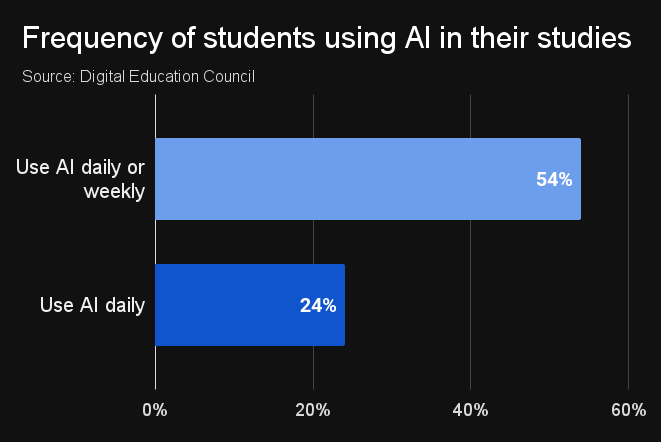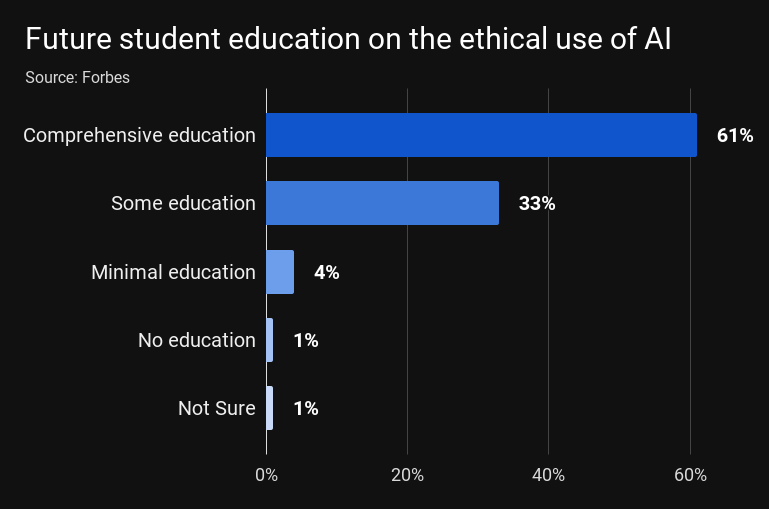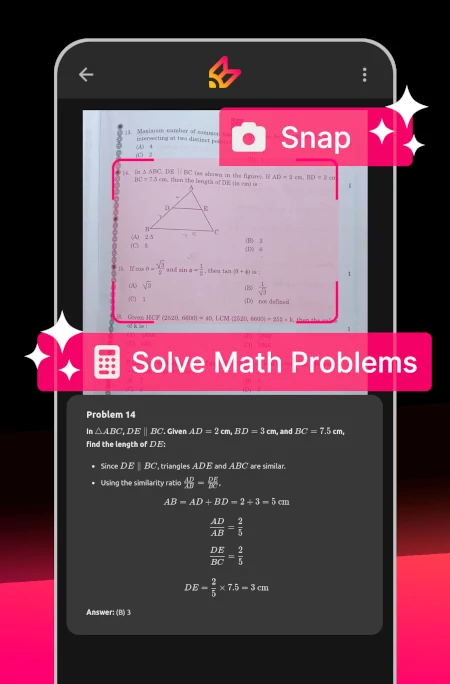Bildung stärken: Wie Generative KI die Art und Weise verändert, wie wir lernen
In der großen Geschichte des menschlichen Fortschritts war Technologie stets das Werkzeug, das Vorstellungskraft und Möglichkeit miteinander verband.

Generative KI in der Bildung
Heute steht die generative KI kurz davor, die Art und Weise zu revolutionieren, wie Schüler und Studenten lernen, kreativ tätig sind und mit der Welt um sie herum interagieren. Aber was ist diese neue Technologie und warum ist sie für jene, die die Welt von morgen gestalten werden, von Bedeutung?
Ein Wendepunkt für Schüler
Für Schüler liegt der Reiz der generativen KI nicht nur in ihrer Kreativität, sondern auch in ihrer schieren Zugänglichkeit. Stellen Sie sich einen persönlichen Lehrer vor, der zu jeder Tageszeit zur Verfügung steht, Erklärungen, Feedback oder Beispiele generiert, die auf den individuellen Lernstil jedes Schülers abgestimmt sind. Ob bei der Vorbereitung auf eine Prüfung, beim Brainstorming von Ideen, beim Zusammenfassen oder Schreiben von Texten, bei der Erstellung eines Kunstprojekts oder bei der Lösung eines komplexen physikalischen Problems – die KI steht bereit als persönlicher Begleiter, unendlich geduldig und stets sich selbst verbessernd.
In einer Welt, in der Schüler oft mit begrenzter Zeit, finanziellen Hürden und ungleichen Zugängen zu Bildungsressourcen kämpfen müssen, bietet die generative KI eine neue Art der Demokratisierung von Wissen. Nicht mehr gebunden an die traditionellen Grenzen des Klassenzimmers oder Lehrbuchs, können Lernende auf dynamische, personalisierte Inhalte zugreifen, wo auch immer sie sich befinden und wann immer sie es benötigen.
Die Zukunft der Generativen KI in der Bildung
Die generative KI wird die Art und Weise, wie wir lehren, wie wir lernen und wie wir über Wissen selbst denken, grundlegend verändern. Was wir heute sehen, ist nur die Spitze des Eisbergs – viele Studierende nutzen KI bereits zur Unterstützung beim Schreiben, für Brainstorming und zur Problemlösung, doch ihr Potenzial reicht weit über diese grundlegenden Anwendungen hinaus.

Der Einflussbereich der KI auf die Bildung ist bereits tiefgreifend. Eine kürzlich durchgeführte Umfrage des Digital Education Council, die Antworten von fast 4.000 Studierenden aus 16 Ländern sammelte, ergab, dass beeindruckende 86 % der Hochschulstudierenden KI in ihrem Studium nutzen, wobei 24 % sie täglich und 54 % mindestens wöchentlich nutzen. Diese Studierenden aus Bachelor-, Master- und Doktorandenprogrammen gaben an, im Durchschnitt 2 KI-Tools für ihre Kurse zu verwenden, wobei ChatGPT mit 66 % das am häufigsten genutzte Tool war, gefolgt von Grammarly und Microsoft Copilot mit jeweils 25 %. KI ist kein vorübergehender Trend; sie wird zunehmend in das Gewebe der modernen Bildung integriert.
Die häufigsten Anwendungen von KI durch Studierende heute umfassen die Suche nach Informationen (69 %), die Überprüfung der Grammatik (42 %) und das Zusammenfassen von Dokumenten (33 %). Während diese Anwendungen bereits die Herangehensweise der Studierenden an ihre Arbeit prägen, kratzen sie kaum an der Oberfläche des tatsächlichen Potenzials der KI. KI-Tools könnten sich zu hochgradig personalisierten Tutoren entwickeln, die sofortiges, maßgeschneidertes Feedback und adaptive Lernerfahrungen bieten, die den individuellen Bedürfnissen der Schüler gerecht werden. Hier liegt das Versprechen von personalisierten Lernumgebungen – eine Zukunft, in der KI nicht nur unterstützt, sondern die Art und Weise, wie Schüler lernen, grundlegend verändert, indem sie Echtzeitunterstützung bietet, sich an verschiedene Lernstile anpasst und sogar Bereiche vorhersagt, in denen Schüler möglicherweise Schwierigkeiten haben, bevor diese auftreten.
Aber es gibt eine Lücke zwischen der aktuellen Nutzung und dem zukünftigen Potenzial. Trotz der weit verbreiteten Nutzung von KI-Tools stellte die Umfrage des Digital Education Council fest, dass 58 % der Schüler das Gefühl haben, dass ihnen ausreichende KI-Kenntnisse und -Fähigkeiten fehlen, und 48 % glauben, dass sie nicht ausreichend auf eine KI-gesteuerte Arbeitswelt vorbereitet sind. Dies ist ein erhebliches Hindernis, das Universitäten und Bildungseinrichtungen angehen müssen. Die Mehrheit der Studierenden (80 %) gab an, dass die Integration von KI-Tools an ihrer Universität nicht ihren Erwartungen entspricht, was einen klaren Bedarf an tieferer, strukturierterer Unterstützung bei der KI-Kompetenz unterstreicht.
Die Schüler selbst haben skizziert, was sie benötigen: 73 % wünschen sich mehr Schulungen für das Lehrpersonal, 72 % erwarten Kurse zur KI-Kompetenz, und 71 % möchten in Entscheidungen über die Nutzung von KI-Tools einbezogen werden. Diese Zahlen machen deutlich, dass die Schüler nicht nur passive Nutzer von KI sind – sie wollen mitgestalten, wie sich diese Tools in ihren Bildungseinrichtungen entwickeln. Sie fordern einen Platz am Tisch, damit Universitäten KI nicht nur als Zusatz, sondern als integralen Bestandteil ihrer Bildungsinfrastruktur betrachten.
Wie Alessandro Di Lullo, CEO des Digital Education Council, betonte, “zwingt der Anstieg der KI-Nutzung Institutionen dazu, KI als Kerninfrastruktur statt als Tool zu betrachten.” Gleichzeitig unterstrich er die Bedeutung des Aufbaus von KI-Kompetenz, um sicherzustellen, dass sowohl Schüler als auch Lehrende die Fähigkeiten besitzen, die sie benötigen, um in einer von KI geprägten Welt erfolgreich zu sein. Es geht hier nicht nur darum, die neuesten Tools zu verwenden; es geht darum, die nächste Generation auf eine Zukunft vorzubereiten, in der KI genauso grundlegend für das Lernen sein wird, wie es einst Lehrbücher und Vorlesungen waren.
Die Rolle der Lehrenden: Das System neu überdenken
Da KI zu einem größeren Bestandteil der Bildung wird, wird sich die Rolle der Lehrenden zwangsläufig ändern. Mehr als die Hälfte der von Forbes befragten Lehrer glaubt, dass KI sich positiv auf den Lehr- und Lernprozess auswirkt, wobei weniger als jeder Fünfte einen negativen Einfluss angibt. Die Zahlen sind eindeutig: 60 % der Lehrenden nutzen jetzt KI-Tools in ihren Klassenzimmern, mit den höchsten Nutzungsraten bei jüngeren Lehrkräften, insbesondere bei denen unter 26 Jahren. Diese neue Generation von Lehrenden führt die Veränderung an und sieht KI nicht als Bedrohung, sondern als mächtigen Verbündeten zur Verbesserung des Lehrens und Lernens.

Noch immer bleiben einige Pädagogen trotz vielversprechender Trends vorsichtig gegenüber KI und konzentrieren sich hauptsächlich darauf, Plagiate und akademische Unehrlichkeit zu verhindern. Wenn diese enge Perspektive bestehen bleibt, riskieren sie, das größere Bild zu verpassen. KI ist nicht der Feind – sie ist ein Partner im Bestreben, das Verständnis der Schüler zu vertiefen, Kreativität zu fördern und Lernprozesse zu personalisieren.
Der Schlüssel liegt nicht darin, KI zu verbieten, sondern darin, zu überdenken, wie wir sie in den Bildungsprozess integrieren. Anstatt ihre Nutzung zu untersagen, sollten Lehrer die Schüler dazu ermutigen, KI auf konstruktive Weise zu nutzen. Zum Beispiel können Schüler KI verwenden, um Ideen zu brainstormen, Grammatik zu überprüfen oder verschiedene Lösungsansätze zu erkunden, solange sie transparent darüber sind, wie und warum sie KI eingesetzt haben. Dieser Ansatz fördert nicht nur kritisches Denken, sondern verstärkt auch die Selbstreflexion der Schüler über die Rolle der Technologie in ihrem Lernprozess.
Darüber hinaus bietet KI enorme Vorteile auch für die Pädagogen selbst. Aufgaben wie das Bewerten von Arbeiten und das Geben von Feedback – notwendig, aber oft zeitaufwändig – können durch KI optimiert werden. KI kann Grammatik, Struktur analysieren und sogar stilistische Vorschläge machen, wodurch Lehrer mehr Zeit haben, sich auf die feineren, menschlichen Aspekte der Bildung zu konzentrieren, wie zum Beispiel die Betreuung von Schülern, die Förderung intensiver Diskussionen und das Anleiten zu tieferem kritischen Denken. So können Lehrer ihre Energie von repetitiven administrativen Aufgaben auf bedeutsame Interaktion mit ihren Schülern verlagern, wo echtes Lernen stattfindet.
Indem Lehrer KI als Produktivitätstool nutzen, können sie sicherstellen, dass kein Schüler auf der Strecke bleibt. Wenn KI die Routineaufgaben übernimmt, haben Lehrer mehr Zeit, sich auf individualisierte Instruktion und Schülerinteraktion zu konzentrieren, die das wahre Herzstück des Lernprozesses ausmachen. Die Zukunft der Bildung liegt nicht darin, KI zu widerstehen, sondern darin, ihr Potenzial zu nutzen, um die menschlichsten Elemente von Lehren und Lernen zu verstärken.
Vorbereitung der Schüler auf eine KI-gesteuerte Welt
Die Integration von KI in die Bildung geht über die Effizienzsteigerung hinaus – es geht darum, die Schüler auf die Welt vorzubereiten, die sie erben werden, eine Welt, in der KI nicht nur ein Werkzeug, sondern eine treibende Kraft in allen Branchen ist. Von der Gesundheitsversorgung bis hin zur Finanzwelt verändert KI bereits die Arbeitswelt, und die Schüler müssen nicht nur über die technischen Fähigkeiten verfügen, um sich in dieser sich schnell verändernden Landschaft zurechtzufinden, sondern auch über das kritische Denken, um ihre umfassenderen Implikationen zu verstehen. Das bedeutet, über das bloße Lernen, wie man KI-Werkzeuge wie ChatGPT oder Grammarly einsetzt, hinauszugehen; die Schüler müssen die ethischen Implikationen, die kreativen Möglichkeiten und die Grenzen dieser Technologien begreifen.

Auch die Lehrer befinden sich in diesem komplexen technologischen Wandel und fordern mehr Anleitung. 98 Prozent der befragten Lehrer identifizierten einen Bedarf an zumindest etwas Bildung zur ethischen KI-Nutzung, wobei mehr als 60 % eine umfassende Bildung empfehlen. Konkret glauben 61 %, dass ein gründliches Verständnis der KI-Ethische von wesentlicher Bedeutung ist, während 33 % der Meinung sind, dass ein gewisses Maß an Ausbildung erforderlich ist, um KI verantwortungsbewusst in den Unterricht zu integrieren. Nur 4 % hielten eine minimale Ausbildung für ausreichend, und nur 1 % sahen keine Notwendigkeit für eine KI-Ausbildung. Dies zeigt einen überwältigenden Konsens unter den Pädagogen, dass das Verständnis der ethischen Dimensionen von KI ebenso wichtig ist wie ihre funktionale Nutzung.
Die Zukunft, die auf die heutigen Schüler wartet, wird eine sein, in der KI nicht mehr eine Neuheit, sondern eine Notwendigkeit ist. Laut dem Digital Education Council fühlt sich fast die Hälfte aller Schüler unvorbereitet auf eine KI-unterstützte Arbeitswelt (48 %), und 80 % glauben, dass ihre Universitäten ihre Erwartungen an die KI-Integration nicht vollständig erfüllen. Dies hebt die Lücke zwischen aktuellen Bildungspraxen und den Fähigkeiten, die die Schüler benötigen, um in einer KI-gesteuerten Wirtschaft erfolgreich zu sein.
Durch die tiefe Integration von KI in das Bildungssystem leisten wir nicht nur einen Beitrag zur Verbesserung des Lernens in der Gegenwart, sondern bereiten die Schüler auf eine Zukunft vor, in der KI ebenso allgegenwärtig sein wird wie das Internet oder Smartphones. Die Aufgabe der Pädagogen besteht darin, nicht nur zu überdenken, wie sie unterrichten, sondern auch, wie sie das Verständnis der Schüler in einer KI-gesteuerten Welt bewerten. Die Schüler dazu zu ermutigen, KI transparent und bedacht zu nutzen, während sie gleichzeitig mit den Fähigkeiten ausgestattet werden, ihre Ergebnisse kritisch zu bewerten, ist entscheidend für diesen Übergang.
Die Frage ist nicht, ob KI die Bildung verändern wird – sie tut es bereits –, sondern wie Schüler, Pädagogen und Institutionen ihre Kraft nutzen werden, um das Lernen persönlicher, zugänglicher und transformierender zu gestalten. Während sich KI weiterentwickelt, muss sich auch unser Ansatz für Lehren und Lernen weiterentwickeln. Die Zukunft von generativer KI in der Bildung bietet enormes Potenzial, und es liegt an uns, diese Zukunft durchdacht, ethisch und mit dem Fokus auf die Schaffung von reicheren und ansprechenderen Lernerfahrungen für jeden Schüler zu gestalten.
Fazit
Generative KI verändert schnell das Bildungsumfeld und bietet Schülern und Pädagogen unvergleichliche Werkzeuge für personalisiertes Lernen und Engagement. Von der Unterstützung der Kreativität beim Schreiben bis hin zur Bereitstellung gezielter Nachhilfe und Feedback hat KI begonnen, Bildungsunterschiede zu überbrücken und den Zugang zu qualitativ hochwertigem Lernen zu demokratisieren. Mit dem Fortschreiten dieser Technologie wird ihre Rolle sich nur vertiefen und nicht nur unser Lernen verändern, sondern auch die Schüler darauf vorbereiten, in einer zunehmend von KI geprägten Arbeitswelt erfolgreich zu sein. Der Schlüssel liegt darin, ein Framework für den verantwortungsvollen Einsatz von KI zu schaffen, damit sowohl Schüler als auch Pädagogen mit den notwendigen technischen Fähigkeiten und ethischen Verständnissen ausgestattet werden, um in dieser dynamischen Zukunft erfolgreich zu navigieren.
Erkunden Sie und beteiligen Sie sich!
Sind Sie ein Schüler, der KI erkundet, ein Lehrer, der daran interessiert ist, sie in seinen Unterricht zu integrieren, oder ein Elternteil, der darüber nachdenkt, wie sie das Lernen seines Kindes unterstützen kann? Wir haben Homework Hero als einfache, zugängliche mobile App für Schüler und Lehrer entwickelt, um zu sehen, was generative KI in Lernen und Lehren zu bieten hat. Ob Sie KI nur ausprobieren oder nach neuen Wegen suchen, Ihre Schüler zu engagieren, wir laden Sie ein, Homework Hero auszuprobieren und uns Ihre Gedanken mitzuteilen, während wir weiterhin daran arbeiten Schüler für die KI-getriebene Welt von morgen stärken.
Kontaktieren Sie uns
Wir schätzen Ihre Fragen, Ideen und Rückmeldungen. Vereinbaren Sie einen Termin für ein unverbindliches Gespräch. Wir freuen uns darauf, mit Ihnen in Kontakt zu treten und Sie auf Ihrem Weg in die Welt der generativen KI zu unterstützen.
Quellen
Frequently Asked Questions
Was ist generative KI?
Wie kann generative KI Schülern und Studierenden helfen?
Welche Vorteile bietet generative KI für den Bildungsbereich?
- Personalisierung: Anpassung an individuelle Lernstile und Bedürfnisse.
- Zugänglichkeit: Lernressourcen sind jederzeit und überall verfügbar.
- Effizienzsteigerung: Schnellere Erstellung und Überarbeitung von Inhalten.
- Demokratisierung des Lernens: Bessere Bildungschancen unabhängig vom sozialen oder finanziellen Hintergrund.
Nutzen Studierende bereits KI für ihr Studium?
Welche Herausforderungen gibt es bei der Nutzung von generativer KI im Bildungsbereich?
- Fehlendes Wissen: 58 % der Studierenden fühlen sich nicht ausreichend über KI informiert.
- Unzureichende Integration: 80 % der Studierenden sind der Meinung, dass KI nicht gut genug in ihre Universität eingebunden ist.
- Ethische Fragen: Der verantwortungsvolle Umgang mit KI muss gelernt werden, um Fehlinformationen, Plagiate und Abhängigkeiten zu vermeiden.
Wie können Lehrkräfte generative KI sinnvoll in den Unterricht integrieren?
- Lerninhalte zu personalisieren und individuell auf Schülerbedürfnisse einzugehen.
- Verwaltungsaufgaben zu automatisieren, z. B. Korrekturen oder Feedback.
- Kritisches Denken zu fördern, indem Studierende lernen, KI-gestützte Inhalte zu hinterfragen und zu bewerten.
- KI als kollaboratives Tool zu nutzen, um kreative Projekte und interaktive Lernformate zu ermöglichen.
Gibt es Bedenken seitens der Lehrkräfte?
Wie können Studierende und Lehrkräfte KI verantwortungsvoll nutzen?
- Transparenz: Offenlegen, wann und wie KI verwendet wurde.
- Kritisches Denken: Ergebnisse der KI immer überprüfen und hinterfragen.
- Ethische Nutzung: KI nicht als Ersatz für eigenes Denken, sondern als unterstützendes Werkzeug nutzen.
- Weiterbildung: Kenntnisse über KI erweitern, um sie effektiver und verantwortungsvoller einzusetzen.
Wie sieht die Zukunft der generativen KI in der Bildung aus?
- Intelligente, adaptive Tutoren, die in Echtzeit individuelles Feedback geben.
- Erweiterte Kollaborationsmöglichkeiten, z. B. durch interaktive KI-gesteuerte Lernplattformen.
- Mehr KI-Kompetenzschulungen für Studierende und Lehrkräfte, um den sicheren und effektiven Einsatz zu gewährleisten.
